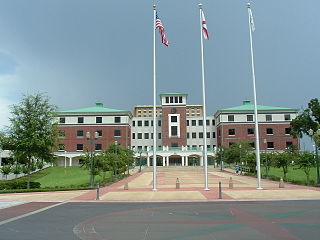
Volusia County is located in the east-central part of the U.S. state of Florida between the St. Johns River and the Atlantic Ocean. As of the 2020 census, the county was home to 553,543 people, an increase of 11.9% from the 2010 census. It was founded on December 29, 1854, from part of Orange County, and was named for the community of Volusia, located in northwestern Volusia County. Its first county seat was Enterprise. Since 1887, its county seat has been DeLand.

Ormond Beach is a city in Volusia County, Florida, United States. The population was 43,080 at the 2020 census. Ormond Beach lies directly north of Daytona Beach and is a principal city of the Deltona–Daytona Beach–Ormond Beach, FL Metropolitan Statistical Area. The city is known as the birthplace of speed, as early adopters of motorized cars flocked to its hard-packed beaches for yearlong entertainment, since paved roads were not yet commonplace. Ormond Beach lies in Central Eastern Florida.
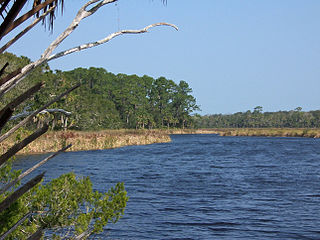
Bulow Creek State Park is a Florida State Park located five miles (8 km) north of Ormond Beach. It is on Old Dixie Highway, next to the Atlantic Ocean. The park is adjacent to Bulow Plantation Ruins Historic State Park, and close to North Peninsula State Park, Gamble Rogers Memorial State Recreation Area and Tomoka State Park.

Bulow Plantation Ruins Historic State Park is a Florida State Park in Flagler Beach, Florida. It is three miles west of Flagler Beach on CR 2001, south of SR 100, and contains the ruins of an ante-bellum plantation and its sugar mill, built of coquina, a fossiliferous sedimentary rock composed of shells. It was the largest plantation in East Florida, and was operated with the forced labor of enslaved Africans and African Americans.

The Judah P. Benjamin Confederate Memorial at Gamble Plantation Historic State Park, also known as the Gamble Mansion or Gamble Plantation, is a Florida State Park, located in Ellenton, Florida, on 37th Avenue East and US 301. It is home to the Florida Division United Daughters of the Confederacy (UDC).

Tomoka State Park is an 2,000-acre (8.1 km2) Florida State Park located along the Tomoka River, three miles (5 km) north of Ormond Beach on North Beach Street.

Yulee Sugar Mill Ruins Historic State Park is a Florida State Park located in Homosassa, off U.S. 19. It contains the ruins of a forced-labor farm owned by David Levy Yulee. Yulee was an enslaver and a delegate of the Florida Territorial Legislative Council. After Florida became a state, he was elected by the legislature in 1845 to the United States Senate, becoming the first American of Jewish heritage to serve there. After Florida seceded from the Union, Yulee served in the Confederate Congress. He is credited with having developed a network of railroads that tremendously boosted the state's economy.
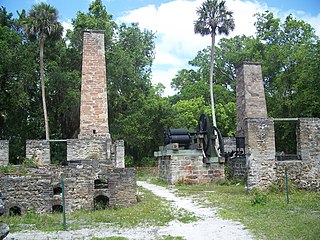
The Dunlawton Plantation and Sugar Mill, a 19th-century cane sugar plantation in north-central Florida, was destroyed by the Seminoles at the beginning of the Second Seminole War. The ruins are located at 950 Old Sugar Mill Road, Port Orange, Florida. On August 28, 1973, the site was added to the United States National Register of Historic Places under the title of Dunlawton Plantation-Sugar Mill Ruins.

The New Smyrna Sugar Mill Ruins is a historic site in New Smyrna Beach, Florida, at 600 Old Mission Road, one mile west of the Intracoastal Waterway. On August 12, 1970, it was added to the U.S. National Register of Historic Places.

Rowallan is a historic site in Ormond Beach, Florida, United States. It is located at 253 John Anderson Highway. On October 6, 1988, it was added to the U.S. National Register of Historic Places.

This is a list of the National Register of Historic Places listings in Volusia County, Florida.

The Tomoka River is a north-flowing river in Volusia County, Florida, United States. It drains an area of about 110 square miles (280 km2) and has a length of 19.6 miles (31.5 km).
The Levi Jordan Plantation is a historical site and building, located on Farm to Market Road 521, 4 miles (6.4 km) southwest of the city of Brazoria, in the U.S. state of Texas. Founded as a forced-labor farm worked by enslaved Black people, it was one of the largest sugar and cotton producing plantations in Texas during the mid-19th century, as well as a local center of human trafficking.

Douglas Dummett (1806–1873) was an American planter, plantation owner, and politician. He served as a member of the Legislative Council of the Territory of Florida representing St. Johns County in 1843, and a member of the Florida House of Representatives representing Mosquito County in 1845. He was instrumental in developing the Indian River Citrus industry in Florida.

Nocoroco is the site of a Timucuan village located on the Tomoka River, in Tomoka State Park. The park is located two or three miles north of Ormond Beach, Florida on North Beach Street.

Fort Morris Historic Site is a Georgia state historic park in Liberty County, Georgia in the United States. The fort is on a bend in the Medway River and played an important role in the protection of southeast Georgia throughout various conflicts beginning in 1741 and ending in 1865 at the conclusion of the American Civil War, including the French and Indian and American Revolutionary Wars and War of 1812. The historic site is 70 acres (28 ha) and sits at an elevation of 23 feet (7.0 m).
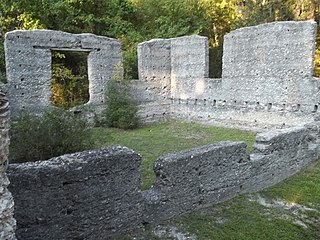
The McIntosh Sugarworks, near St. Marys, Georgia, was built in the late 1820s by John Houstoun McIntosh. They are a significant example of tabby concrete architecture and represent an industrial component of southeastern plantation agriculture. The Tabby Ruins, as they are also known, are at 3600 Charlie Smith Sr. Highway at Georgia Spur 40, six miles north of St. Marys. The entrance is approximately across the street from the entrance to the Naval Submarine Base Kings Bay, on Charlie Smith Highway, at 30.79310°N 81.57712°W.
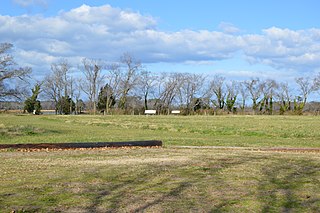
Arlington Archeological Site is a historic archaeological site located near Capeville, Northampton County, Virginia. It is located east of the Custis Tombs. The site includes archaeological features ranging from Accomack Plantation, the first English settlement of the Eastern Shore in 1619, to probable tenant or slave quarter features dating to the second half of the 18th century. The site also includes the foundations of Arlington mansion, established about 1670 and demolished about 1720. Arlington plantation was the ancestral home of the Custis family of Virginia. Archaeological investigations and excavations of the site were conducted in 1987-1988 and 1994.

Estate Judith's Fancy, subdistrict of Saint Croix, U.S. Virgin Islands, 4 miles (6.4 km) northwest of Christiansted is a former sugarcane plantation whose great house was built in 1733. Its surviving 3.6 acres (1.5 ha) property was listed on the National Register of Historic Places in 1978. The listing included six contributing sites.

Addison Blockhouse Historic State Park is a state park located in Volusia County, Florida. It features the Addison Blockhouse, a small coquina rock ruin that was on a 19th-century plantation and served as a kitchen as well as a fort.





















